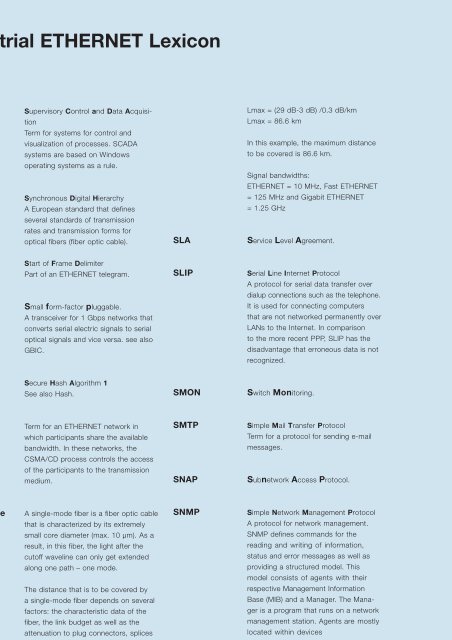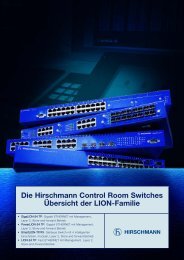Industrial ETHERNET
Industrial ETHERNET
Industrial ETHERNET
- No tags were found...
You also want an ePaper? Increase the reach of your titles
YUMPU automatically turns print PDFs into web optimized ePapers that Google loves.
<strong>Industrial</strong> <strong>ETHERNET</strong> Lexicon<br />
SCADA<br />
SDH<br />
Supervisory Control and Data Acquisition<br />
Term for systems for control and<br />
visualization of processes. SCADA<br />
systems are based on Windows<br />
operating systems as a rule.<br />
Synchronous Digital Hierarchy<br />
A European standard that defines<br />
several standards of transmission<br />
rates and transmission forms for<br />
optical fibers (fiber optic cable).<br />
SLA<br />
Lmax = (29 dB-3 dB) /0.3 dB/km<br />
Lmax = 86.6 km<br />
In this example, the maximum distance<br />
to be covered is 86.6 km.<br />
Signal bandwidths:<br />
<strong>ETHERNET</strong> = 10 MHz, Fast <strong>ETHERNET</strong><br />
= 125 MHz and Gigabit <strong>ETHERNET</strong><br />
= 1.25 GHz<br />
Service Level Agreement.<br />
SFD<br />
SFP<br />
Start of Frame Delimiter<br />
Part of an <strong>ETHERNET</strong> telegram.<br />
Small form-factor pluggable.<br />
A transceiver for 1 Gbps networks that<br />
converts serial electric signals to serial<br />
optical signals and vice versa. see also<br />
GBIC.<br />
SLIP<br />
Serial Line Internet Protocol<br />
A protocol for serial data transfer over<br />
dialup connections such as the telephone.<br />
It is used for connecting computers<br />
that are not networked permanently over<br />
LANs to the Internet. In comparison<br />
to the more recent PPP, SLIP has the<br />
disadvantage that erroneous data is not<br />
recognized.<br />
SHA-1 Secure Hash Algorithm 1<br />
See also Hash.<br />
SMON<br />
Switch Monitoring.<br />
Shared<br />
Network<br />
Term for an <strong>ETHERNET</strong> network in<br />
which participants share the available<br />
bandwidth. In these networks, the<br />
CSMA/CD process controls the access<br />
of the participants to the transmission<br />
medium.<br />
SMTP<br />
SNAP<br />
Simple Mail Transfer Protocol<br />
Term for a protocol for sending e-mail<br />
messages.<br />
Subnetwork Access Protocol.<br />
Single-mode<br />
Fiber<br />
278<br />
A single-mode fiber is a fiber optic cable<br />
that is characterized by its extremely<br />
small core diameter (max. 10 µm). As a<br />
result, in this fiber, the light after the<br />
cutoff waveline can only get extended<br />
along one path – one mode.<br />
The distance that is to be covered by<br />
a single-mode fiber depends on several<br />
factors: the characteristic data of the<br />
fiber, the link budget as well as the<br />
attenuation to plug connectors, splices<br />
and other components.<br />
Example:<br />
A 9/125 µm fiber with an attenuation (A)<br />
of 0.3 dB/km should transmit a wavelength<br />
of 1550 nm of Fast <strong>ETHERNET</strong><br />
data packets. The link budget is 29 dB.<br />
A reserve of 3 dB is taken into account.<br />
The attenuation of the plug connector<br />
is to be ignored.<br />
Attenuation:<br />
Lmax = (Link Budget-Reserve)/<br />
Fiber attenuation<br />
SNMP<br />
Simple Network Management Protocol<br />
A protocol for network management.<br />
SNMP defines commands for the<br />
reading and writing of information,<br />
status and error messages as well as<br />
providing a structured model. This<br />
model consists of agents with their<br />
respective Management Information<br />
Base (MIB) and a Manager. The Manager<br />
is a program that runs on a network<br />
management station. Agents are mostly<br />
located within devices<br />
such as switches, routers and terminal<br />
devices that support the SNMP. The<br />
task of the agents consists in collecting<br />
and preparing data in the MIB. These<br />
data is requested at regular intervals<br />
by the Manager and displayed on the<br />
network management station. The<br />
devices are configured, for example,<br />
with the data that the Manager writes to<br />
the MIBs in question. In urgent cases,<br />
the agent can also send messages<br />
(traps) directly to the Manager.











